The Historical Sew Fortnightly ‘Flora and Fauna’ challenge fortnight starts on Tuesday, and I’m SO excited about it.
I love using the natural world as inspiration: I’ve done it with the Juno Gown (melding Greek/Roman mythology and nature with the peacock motif) and with the Luna Moth gown, plus the Laurel Gown, which also used natural motifs and classical inspiration. I also do it with not-so-historical garments, like Carolyn’s wedding gown, which borrowed from both butterflies and fish, and with Shell’s wedding dress, which borrowed from native New Zealand birds.
There are so many different ways to interpret ‘Flora and Fauna’ – you can simply use fabrics that depict flora or fauna, or fabrics made from flora or fauna, or can add in flora and fauna based motif, or you could create a garment that is inspired by the aesthetic of a particular bit of flora or fauna. The last bit brings to mind the yellow and black Regency dress that I posted a few months back that many people felt had been inspired by a bee. That’s pure conjecture, but we do know there were historical garments inspired by the natural world. Louisa May Alcott described married Meg as wearing a grey dress that made her look like a little dove, and Emily spends the entire payment for a story on a dress that reminds her of a specific summer evening.
I had the most exciting project planned for the Flora and Fauna challenge: a replica of an embroidered 1920s dress in my collection that combines a very traditional feminine nature motif (a butterfly) with the exciting colours and broken lines of Fauvism, Futurism and Cubism. Alas, while I located half the fabrics and embroidery threads needed, a reasonable match to the fabric I would be embroidering on has eluded me, so I’ve put the project on hold until I can find the right fabric. There is no point in spending a hundred hours embroidering on a less than ideal fabric.
Instead, I’ll be making one delicious 18th century accessory, and a 1930s capelet for a dear friend for the challenge. Not what I’d intended, but wonderful none-the-less.
Here are a few of my favourite flora and fauna inspired garments:
First, you have to look closely, but Lady Arabella’s skirt is spiderweb patterned. I am SO in love. SO IN LOVE. My wedding veil was a piece of 1910s metal lace with spider webs. I like spiders, and I LOVE spiderweb motifs.
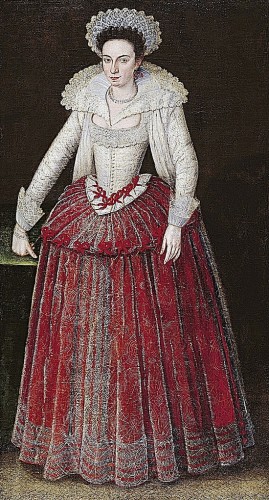
Lady Arabella Stuart by Marcus Gheeraerts the Younger, Norton Simon Museum, Pasadena, Ca, ca. 1605-10
I adore this workbag. I’m sure the embroidery is meant to be flowers, but it’s so delicious and juicy looking that I like imagining it as berries.

Workbag, 1701, linen with wool crewel embroidery, V&A
Look at this fichu worked with lace bees! How sweet is that! (though, of course, it was actually a political statement at the time, as the bee was a Napoleonic symbol).
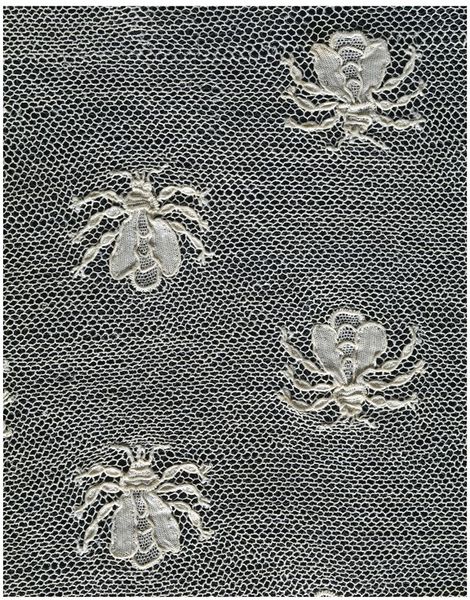
Fichu, Alençon, France, ca. 1805-1810, Needle lace worked in linen thread on a net ground, V&A
There are all sorts of divine Regency items with flora and fauna motifs. This dress, with its hem garland of oak leaves, just makes me swoon.

Dress, 1807—10, Italian, Metropolitan Museum of Art
Clearly I’m not expecting anyone to make one of these, but I still can’t help showing you one of those tiaras that I love so much:
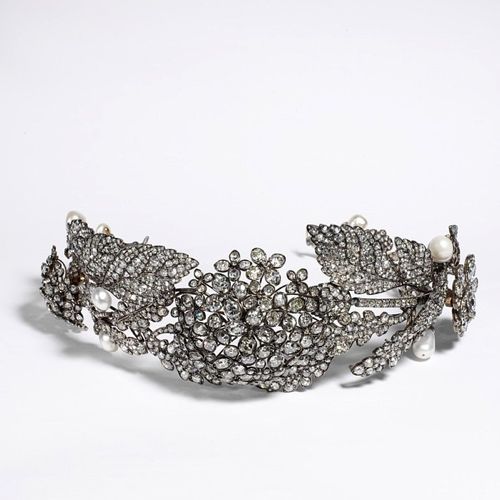
Tiara, 1850, V&A
These shoes are a great example of how simple floral inspiration can be. And the whole silhouette of these shoes is just divine. I’m keeping an eye out for modern shoes with this look that I could re-make to be more historical.
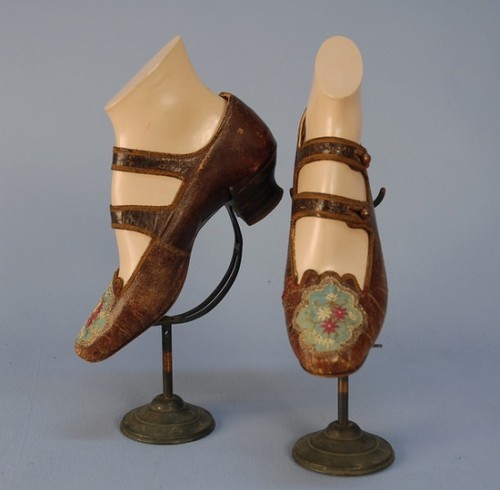
1870’s shoes of brown leather with double button strap, stacked wooden heel, the toe having a cutout scalloped oval inset with floral embroidered blue silk faille, Whitaker Auctions
In general, I don’t like 20th century vintage cherry motifs, but I love these 1870s stockings. If I ever find nice silk or cotton knit with a cherry pattern I’m going to make my own!
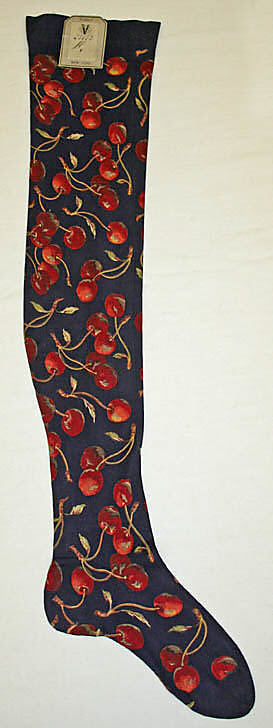
Stockings, 1870, French, cotton, Metropolitan Museum of Art
I think this butterfly inspired cape is just fantastic. It’s just another piece of proof that garments really can literally be flora or fauna inspired.
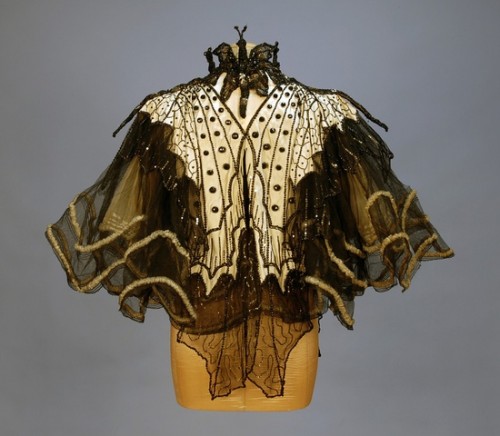
Pingat Jet Beaded Butterfly Evening Cape (back), 1890’s, sold through Whitaker Auctions
Isn’t the fabric on this ’20s dress just fabulous? Its also a great inspiration piece for Eastern Influence.

1924 Redfern of London dress, Hillwood Estate
Ah, so many pretty inspiration pieces, so little time to sew! If you want to see more, check out my Flora and Fauna pinterest page.

Bug inspired clothes are awesome!
I had never seen that spiderweb skirt before, or the butterfly cape, but now I’m madly in love with both of them.
I actually have a bug that I’ve been planning to use as a hat ornament. It’s a wasp about 10 cm long made of wire, covered in black velvet and decorated with seed beads. It’s almost finished and I’d like to put it on a little hat with a veil. Is there any time period for which that could be considered accurate? I have seen some weird stuff on early 20th century hats, like dead parrots, but I’m not sure about sparkly fake bugs.
If not then I could hurry up and finish my strawberry pockets.
This was an awesome inspiration post, I hadn’t seen any of these garments before. Those cherry stockings are fabulous.
Hi Mouse – May I direct you to Schiaparelli’s “Pagan” hat?
http://collections.vam.ac.uk/item/O133550/the-pagan-collection-hat-elsa-schiaparelli/
And I’ve certainly seen quite a few earlier hats trimmed with bugs and beetles – your wasp sounds fabulous and I bet it would look fantastic perched on a 1930s style Schiaparelli-style percher hat, or even on a 1910s velvet toque or 1920s cloche.
Yay! What gorgeous bugs that hat has.
I’m so glad to hear that bugs are accurate, they’re much nicer than stuffed birds.
I don’t know much about 20th century fashion, so this was very helpful. Thank you.
I love the oak leaves as decoration. I could see myself using linden leaves as decoration… because while I’m generally repulsed by hearts as decoration, I love the heart shape of a linden leaf…
But I’m going to try and make that striped Regency dress, because I completely forgot to make it in time for the Stripes challenge and there are flowers on the fabric and I want to make it anyway.
Like Mouse Borg, I have not seen most of these before – only the cherry stockings, and I’d totally wear those, too.
I should look up some bat inspiration, some that would not be too freaky, because like you love spiders, I love bats.
(I saw a young man the other day wearing quite respectable clothes, with a quite respectable dark overcoat – until I saw him from the back and the overcoat had a batty pelerine. Then, I went “Cool!” Something like that.)
vam.ac.ukButterflies were the theme of today’s PDP blog post at the V&A –
http://www.vam.ac.uk/b/blog/factory-presents-revealing-prints-drawings-paintings-photographs-and-digital-art-collections/bu
And I now want a batty pelerine coat….
Thank you, Daniel! I really enjoyed your butterflies.
So many good things! Love the spider-web skirt, love the cherry stockings! I look forward to seeing the things people make for this challenge – I’m a spectator here.
I love all of these examples, and I’m really looking forward to this challenge.
Oh fantastic! I’m so pleased you are doing this one! We should do a Wellington HSF meet-up/photoshoot.
I’ve just discovered the “Historically Accurate Disney Princesses” by shoomlah on deviantART; and while it’s of course not period inspiration, it’s still inspiration, and it’s great:
http://shoomlah.deviantart.com/art/It-s-not-my-style-260710208
gutenberg.orgSome literary inspiration, from Gene Stratton Porter’s GIRL OF THE LIMBERLOST (1909)–the dress described is supposed to be based on the Yellow Emperor moth, which she chooses as inspiration rather than the Luna Moth:
For she stood tall, lithe, of grace inborn, her dark waving hair high piled and crossed by gold bands studded with amethyst and at one side an enamelled lavender orchid rimmed with diamonds, which flashed and sparkled. The soft yellow robe of lightest weight velvet fitted her form perfectly, while from each shoulder fell a great velvet wing lined with lavender, and flecked with embroidery of that colour in imitation of the moth. Around her throat was a wonderful necklace and on her arms were bracelets of gold set with amethyst and rimmed with diamonds. Philip had said that her gloves, fan, and slippers must be lavender, because the feet of the moth were that colour. These accessories had been made to order and embroidered with gold. It had been arranged that her mother, Philip’s, and a few best friends should receive his guests. She was to appear when she led the grand march with Philip Ammon. Miss Carr was positive that she would be the most beautiful, and most exquisitely gowned woman present. In her heart she thought of herself as “Imperialis Regalis,” as the Yellow Empress.
http://www.gutenberg.org/files/125/125-h/125-h.htm
Er, some things went wrong with that, but you get the point 🙂
Thanks! According to the book, the Yellow Emperor gown was made by Paquin. Swoon! Have you realised that I made a Luna Moth dress?
Yes, and in fact when I was scrolling through your archives when I started following your blog, I saw that title and was SURE it had to be a Girl of the Limberlost reference!
I didn’t realize Paquin was the designer–that name was meaningless to me as a kid, but I’ve always remembered the description of her dress. Too bad Edith is the book’s villain 🙂
[…] been thinking about the Flora and Fauna challenge for Historical Sew Fortnightly. It is challenge number 9 (and likely one I will not be able to pull off because of other […]
[WORDPRESS HASHCASH] The comment’s server IP (66.155.8.111) doesn’t match the comment’s URL host IP (66.155.9.238) and so is spam.
I’ve finished my Flora and Fauna project. Nothing too exciting, but I’m inching my way back into the challenges after a big move.
http://livingwithjane.blogspot.com/2013/04/historical-sew-fortnightly-challenge-9.html
Welcome back! It’s a lovely capote – excellent colours on you! I’m taking this challenge a wee bit easy too to give me time to work on bigger upcoming challenges.
I’ve just posted about my HSF #9 garment: an 1815 “Tree Gown.”
http://quinnmburgess.wordpress.com/2013/05/02/the-tree-gown-for-real-hsf-9/
Best,
Quinn
I am so in love with that dress! It captures the period so beautifully!
Finished mine just in time!
http://wandabvictorian.wordpress.com/2013/05/06/whew-just-made-it/
This is part of the ongoing Beaded Dress Project, but as I’ve finished beading the flowers, I wrote up how I did them.
http://blacktulipsewing.blogspot.co.uk/2013/05/how-to-bead-lotus-flower.html
http://isabelladangelo.blogspot.com/2013/05/historical-fortnightly-9-flora-and-fauna.html
Just a simple 18th C jacket.
I made a 1910’s velvet toque with a wasp on it.
http://mouseborgdesigns.blogspot.ca/2013/05/the-wasp-hat-is-done.html
Floral/stripe indienne 1770-80s robe à l’anglaise en fourreau.
http://keowyndrials-closet.blogspot.com/2013/05/done-hsf-9-floral-indienne-anglaise-en.html is the culmination post of a series (first time making an anglaise en fourreau).
Accomplished two challenges in one with this curtain dress 🙂
http://cursewordsandcrinolines.blogspot.com/2013/05/historical-sew-fortnightly-challenge-9.html
I embroidered a colonial pocket.
http://teacupsamongthefabric.blogspot.com/2013/04/an-embroidered-colonial-pocket-for-hsf.html
Laurie
I have moved my blog so this is the new location for the 18th century colonial pocket. http://teacupsinthegarden.blogspot.com/2013/05/an-embroidered-colonial-pocket-for-my.html